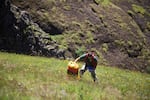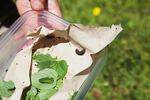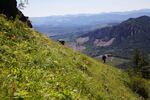For the first time in 40 years, there are Oregon silverspot butterflies on Saddle Mountain.
With containers full of caterpillars loaded painstakingly into backpacks, a team of biologists, zookeepers and park rangers winds its way up an increasingly steep trail. They're headed for the few, isolated meadows capable of supporting the endangered butterfly.

Michael Cash, a keeper with the Woodland Park Zoo in Seattle, removes a container full of threatened silverspot caterpillars from his backpack.
Erin Ross/OPB
The butterfly was once common in coastal meadows across the Northwest, ranging from northern California to central Washington. But by the 1980s, the butterfly was federally listed as threatened. By the 1990s, only four populations remained.
As they climb, it becomes clear why this site was chosen for reintroduction. Thousands of hikers visit Saddle Mountain each year in northwestern Oregon. Still, the steep meadows remain untouched and verdant. This makes Saddle Mountain a pollinator’s paradise. Swallowtail butterflies, moths, and native bees float from flower to flower. Grasshoppers and beetles hide within dense foliage.
Occasionally someone on the team stops to point out a rare insect or plant. Later, one of them might return to gather seeds from the area, which will be used to restore other prairies. Richard Szlemp, a wildlife biologist with the U.S. Fish and Wildlife Service, bends over to point out a pearly-white spider that captured a bee twice its size and is feasting on it, holding the insect by the head.

A honeybee is slowly devoured by a spider on Saddle Mountain.
Erin Ross/OPB
These meadows along the mountainside are robust and diverse. They have plenty of food for adult silverspots, but they're not quite the right habitat for the caterpillars. The caterpillars eat just one plant: Viola adunca, the early blue violet.
Celeste Lebo, a natural resources coordinator for the Oregon Parks and Recreation Department and the trip leader, has identified three areas with the highest populations of the violet, near the top of the mountain.
These areas have dense patches of violets, perfect for the caterpillars. It doesn’t matter how many violets there are in an area overall, explains Anne Walker, a biologist with U.S. Fish and Wildlife Service and the head of the Oregon Silverspot Butterfly Project. It matters how dense they are. Research has shown that silverspot caterpillars are bad at finding violets to eat. It’s also shown that they don’t move far from the plant they were born on. If they leave a host plant and there isn’t another nearby, they’ll starve.

Two silverspot caterpillars in a container with early blue violet leaves, the only food they eat.
Erin Ross/OPB
It’s their precise diet, in part, that’s put the silverspots on the brink of extinction. The early blue violet vanished from much of its historic range, out-competed by invasive species. Many of the nectar-rich plants the adult butterflies drink from have also vanished, replaced by grasses preferred by grazing cattle.
As they reach the meadows, the biologists, zookeepers, and park rangers separate into different groups and begin placing the caterpillars. The violets, which are long past bloom, aren’t easy to spot: little green patches nestled in a sea of even more green.
“You get an eye for it,” insists Trevor Taylor, a stewardship division manager with the Oregon Parks and Recreation Department, gently placing a plump caterpillar on a cluster of violet leaves. It immediately begins eating. “That’s what we like to see.”
It’s precarious work. The meadows are steep and exposed. The sun is strong. The footing is treacherous. At one point, a backpack full of caterpillars begins to roll down the hillside. It’s stopped by some bushes just above a drop-off and carefully retrieved.
The team is cautiously optimistic about Saddle Mountain. It has a lot in common with the most successful silverspot ecosystems. And it's the first time they've ever released butterflies in a location that didn't need at least some habitat restoration.
Over the course of the day, more than 600 caterpillars are gently deposited on the mountainside. As long as a few survive to adulthood, mate, and lay eggs, Walker will consider it a success. “A female butterfly can lay up to 200 eggs,” she says. “It only takes two to start a population.”

Dozens of takeout containers hold hundreds of silverspot caterpillars.
Erin Ross/OPB
Mystery Of The Vanishing Butterflies
No one knows why silverspot butterflies disappeared from Saddle Mountain in the 1970s. In other locations along the coast, the culprits are obvious: agriculture, livestock grazing and invasive plants have decimated the silverspot’s habitat. When U.S. Fish and Wildlife Services first began breeding the Oregon silverspot butterfly, they had only been found at one location: the top of Mount Hebo in the Oregon Coastal Range.
Soon, a handful of other locations were discovered. But unlike Mount Hebo, these habitats were severely degraded. Biologists with Fish and Wildlife Services started working with zoos to raise silverspot caterpillars in the lab and release them to supplement populations. Eventually, they began rehabilitating some old and new silverspot habitat, removing invasive species and planting native ones. They began working with agricultural operations to produce the seeds for native plants that the butterflies need.
It’s taken a long time, Walker says, and a lot of trial and error. But they’re getting better and better at restoring these meadows.
In 2017, for the first time, an entirely new population of silverspot butterflies was established in Nestucca Bay Wildlife Refuge, following a massive ecosystem restoration project.
About 6 percent of the caterpillars placed in Nestucca survived to become butterflies. Walker says that’s expected.
“Silverspot butterflies used to be a part of the ecosystem,” she says. “They’re pollinators. They eat plants when they’re caterpillars, and some things eat them. Even if they die, they’re serving the ecosystem.”
Just a few days before the trip to Saddle Mountain, they had some more good news.
“It’s a little early for them, but we saw a silverspot butterfly at Nestucca,” Walker says. The butterfly might be an adult that survived the winter — or it might be new, the offspring of last year’s release.
But even as new populations are established, old ones are vanishing. “There’s one or two we can expect to lose in the next few years, because of how the ecosystem is managed,” Walker says. They’re making progress but it’s slow. Right now, Walker thinks there are about six populations of silverspot butterflies. Under the species’ recovery plan, the goal is to have at least 10 sites with robust butterfly numbers.
Even the Mount Hebo population has struggled. Hotter summers and severe drought in recent years have caused die-offs in the early blue violets on the mountain. The local population of butterflies dropped. They can’t rely on just one ecosystem to keep them going in the wild anymore. More locations are needed. And the Mount Hebo location, too, has had trouble with invasive species.
But none of that happened at Saddle Mountain. There was no agriculture, no grazing cattle. The mountaintop meadow was isolated and at a high elevation: the few invasive weeds that rode the winds towards the mountain were smothered by snow. By the time the researchers knew the butterfly was in danger, it had vanished from the mountain.
“Maybe it was climate change. Maybe it was a drought like the one on Mount Hebo,” Walker says. “Maybe it was spraying from surrounding logging operations. The park didn’t used to be this big.”

Biologists search for the early-blue violet in a steep meadow on Saddle Mountain.
Erin Ross/OPB
Once the butterflies vanished, they had no way to return. Saddle Mountain is isolated and silverspot butterflies rarely travel more than 4 miles. Enter humans, with cars and backpacks full of wiggly caterpillars.
Biodiversity Matters
It might seem strange to invest so much energy — literally, decades of it — in saving a single insect. But biodiversity is important to ecosystems, Taylor notes, and insects are incredibly diverse.
Scientists estimate there are about 180,000 species of butterflies and moths. In comparison, it's believed there are around 70,000 species of vertebrates, and fewer than 6,000 are mammal species. Despite this, insects, in general, are understudied: researchers believe that as many as 80 percent of insect species remain undiscovered. Insect populations are plummeting and scientists worry that they may be going extinct faster than we can discover them.
“Prairies like this one are incredibly diverse,” Taylor says. “But the loss of biodiversity across this country and around the world is extremely high and only increasing.”
Although the silverspot is just one insect, it interacts with everything else in its ecosystem, Taylor explains. And robust, diverse ecosystems hold up better to man-made pressures like climate change. If the butterflies survive to reproduce, Saddle Mountain’s ecosystem will be that much stronger.

